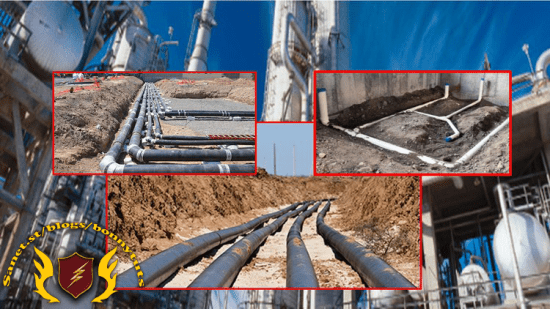Under-Ground Piping Networks & Stress Analysis
Piping & Stress Analysis for UG

What you'll learn
All about Under Ground Piping
Basic Definitions
Various Rules to be followed
General Terms : Catch basin, Manholes, Valve Pits, Diversion Pits, Invert Elevations, Listing Stations
Various Underground Networks : Oily water, Contaminated Rain water, Cooling Water, Closed drain networks
Trench Piping
Composite drawings
Scope & Responsibility Splits
Stress Analysis for Underground Networks
Step By Step Modelling
Load Cases, Caeser Results and Reports
Requirements
Willing Ness to Learn
Description
What you'll learn
All about Under Ground Piping
Basic Definitions
Various Rules to be followed
General Terms : Catch basin, Manholes, Valve Pits, Diversion Pits, Invert Elevations, Listing Stations
Various Underground Networks : Oily water, Contaminated Rain water, Cooling Water, Closed drain networks
Trench Piping
Composite drawings
Scope & Responsibility Splits
Stress Analysis: Complete content is prepared by Mr. Anup Dey (Special Thanks for valuable contribution)
Setting Ground Work
Documents/Input Required
Input parameters in Caesar
Settings Unit Systems
Pipe/Soil Properties
Pipeline Profile drawings
·Codes & Standards used
AG & UG Pipeline
Step By Step Modelling
Various tools of Caeser II
Pipeline, Fittings, Supports
Best Practices while modeling/Analysis
Modeling of Buried pipe
U/G Pipe modeler Tool
Parameters in Soil Modelers
Load Cases, Caeser Results and Reports
Creating Load Cases, w.r.t. Various parameters
Analyzing Caeser results
Generating stress reports
Concluding Stress Results and Reports
This covers, Why UG piping is required, what basic rules need to be followed. It covers most the underground items eg. Catch basin, Manholes, Valve Pits, Diversion Pits, Invert Elevations, Listing Stations. Various open and closed drain networks are also covered along with Cooling water network. Most of the critical things about Composite drawings are also covered eg What are those drawings and why those drawings are required, who are the various stakeholders involved and basic required to generate these drawings.
Various drawings, cross sectional views have been added at various stage of the course which can be very useful to understand the fundamentals.
In the end we will discuss the various scope & responsibility splits among various disciplines. all phases from Proposal to Feed to Detailed design stages have been covered to understand the scope & responsibilities of various disciplines.
In this course my Dear Friend Mr. Laxmikant Sawleshwarkar has helped a lot. His contributions have really helped to add more value to the content. I am sure he is going to contribute in upcoming courses too.
Dont miss to provide your feedback.
Who this course is for
Process industry people
MP4 | Video: h264, 1280x720 | Audio: AAC, 44.1 KHz, 2 Ch
Genre: eLearning | Language: English + srt | Duration: 23 lectures (2h 51m) | Size: 1 GB
Download
http://s6.alxa.net/one/2022/03/Under...s.Analysis.rar
Piping & Stress Analysis for UG

What you'll learn
All about Under Ground Piping
Basic Definitions
Various Rules to be followed
General Terms : Catch basin, Manholes, Valve Pits, Diversion Pits, Invert Elevations, Listing Stations
Various Underground Networks : Oily water, Contaminated Rain water, Cooling Water, Closed drain networks
Trench Piping
Composite drawings
Scope & Responsibility Splits
Stress Analysis for Underground Networks
Step By Step Modelling
Load Cases, Caeser Results and Reports
Requirements
Willing Ness to Learn
Description
What you'll learn
All about Under Ground Piping
Basic Definitions
Various Rules to be followed
General Terms : Catch basin, Manholes, Valve Pits, Diversion Pits, Invert Elevations, Listing Stations
Various Underground Networks : Oily water, Contaminated Rain water, Cooling Water, Closed drain networks
Trench Piping
Composite drawings
Scope & Responsibility Splits
Stress Analysis: Complete content is prepared by Mr. Anup Dey (Special Thanks for valuable contribution)
Setting Ground Work
Documents/Input Required
Input parameters in Caesar
Settings Unit Systems
Pipe/Soil Properties
Pipeline Profile drawings
·Codes & Standards used
AG & UG Pipeline
Step By Step Modelling
Various tools of Caeser II
Pipeline, Fittings, Supports
Best Practices while modeling/Analysis
Modeling of Buried pipe
U/G Pipe modeler Tool
Parameters in Soil Modelers
Load Cases, Caeser Results and Reports
Creating Load Cases, w.r.t. Various parameters
Analyzing Caeser results
Generating stress reports
Concluding Stress Results and Reports
This covers, Why UG piping is required, what basic rules need to be followed. It covers most the underground items eg. Catch basin, Manholes, Valve Pits, Diversion Pits, Invert Elevations, Listing Stations. Various open and closed drain networks are also covered along with Cooling water network. Most of the critical things about Composite drawings are also covered eg What are those drawings and why those drawings are required, who are the various stakeholders involved and basic required to generate these drawings.
Various drawings, cross sectional views have been added at various stage of the course which can be very useful to understand the fundamentals.
In the end we will discuss the various scope & responsibility splits among various disciplines. all phases from Proposal to Feed to Detailed design stages have been covered to understand the scope & responsibilities of various disciplines.
In this course my Dear Friend Mr. Laxmikant Sawleshwarkar has helped a lot. His contributions have really helped to add more value to the content. I am sure he is going to contribute in upcoming courses too.
Dont miss to provide your feedback.
Who this course is for
Process industry people
MP4 | Video: h264, 1280x720 | Audio: AAC, 44.1 KHz, 2 Ch
Genre: eLearning | Language: English + srt | Duration: 23 lectures (2h 51m) | Size: 1 GB
Download
http://s6.alxa.net/one/2022/03/Under...s.Analysis.rar